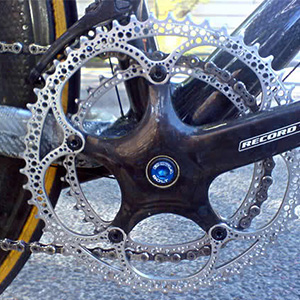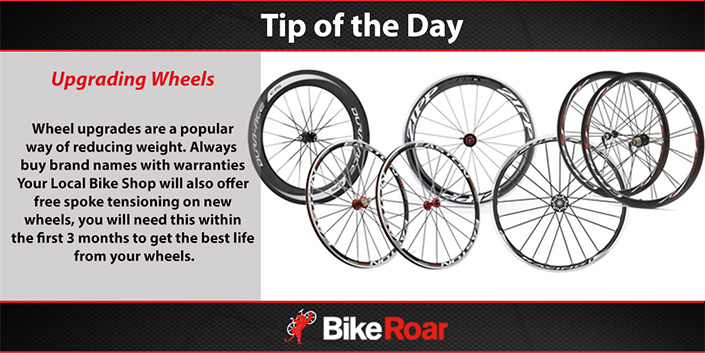
Cycling is a sport very much affected by ones power to weight ratio. It's the driving force behind bikes becoming lighter and the number one reason professional cyclists try to control their body weight. But the average weekend rider can't drop kilos of body weight without affecting their normal lifestyle so they tend to turn to their bikes in a bid to lose unwanted weight.
There are many ways to lighten your bike, some more costly than others. We've consulted some of our listed Local Bike Shops for input on this, to put together a short list of weight loss methods - for your bike. Not you.
1. CHEAPEST: Race Trimming
If you're a bit of a home mechanic and take pride in your ride you can give your bike a 'race trim' makeover. This is a detailed overview of your bike - removing anything you don't need. It might seem ridiculous, but the bike will look insanely sexy afterwards and be some grams lighter. You'll need the usual bike related tools, as well as cable cutters and cable ends plus a few replacement parts. This approach requires no additional purchases, only replacement of parts that would wear out anyway (such as cable inners).

Image: forums.mtbr.com
- Remove all valve caps and valve thread nuts.
- Shorten all cable sheathings, to be shortest distance possible. Accommodate handlebar rotation.
- Shorten inner cables and trim them as short as possible, enough to fit a cable end onto it.
- Cut steerer tube shorter, and remove as many spacers as possible.
- Cut seatpost shorter, to remove excess post - maintain 'minimum insert' gap as marked on seatpost.
This approach will not save you a lot of weight, although your bike will be a few grams less. The main appeal is a bike that looks professional and well maintained. Have pride in your ride!
2. EASIEST: Replace Everything
The easiest way to reduce the weight of your bike is to replace major parts. It's not the cheapest way and could be an open invitation for your local bike shop to suggest a total bike upgrade due to the inherent cost. This is a very good point, so do consider buying a new bike that comes stock standard with this awesome gear. But if you must, here's what you can do...

- Upgrade to a lighter and smoother groupset (all shifting and braking components) to save several hundred grams in one hit.
- Upgrade your wheels to something lighter, potentially carbon fibre and a wee bit aerodynamic. This is the most popular upgrade!
- Upgrade your cockpit to lightweight alloy or carbon - handlebars, stem, seatpost and saddle. Again, hundreds of grams shaved.
- Upgrade your tires and tubes to lightweight racing ones. Not a big difference, but usually done alongside the wheel upgrade.
- Cut seatpost shorter, to remove excess post - maintain 'minimum insert' gap as marked on seatpost.
This method is pretty costly, and replaces everything except the frame. This means you have new components on an old frame, leaving you wondering if it was all worthwhile. Just replace the whole bike, or avoid the total overhaul. If you feel the need to upgrade parts, but don't want to be stupid about it, read the next point!
3. VALUE FOR MONEY: Upgrade the Wheels

Upgrading your wheels is the best value for money when it comes to improving the quality of your ride. Not only does your bike weight less, but the wheels will also perform much better than the originals. This is courtesy of smoother bearings and more precise freewheel systems resulting in much less rolling resistance. Wheel upgrades are relative to what you currently ride, so ask your local bike shop for advice on what would be considered an upgrade, given your current wheelset.
4. PLAIN STUPID: New Bike & Upgrades
You know what they say - #yolo. (If you don't get it, you're all that keeps this world normal. We thank you.)
If you just won the lottery, or mugged several thousand people, you could consider buying a new bike AND upgrading the parts on it. You'll be left with something exceeding the value of your house, but here's how it's done.
- Buy a carbon fiber road bike that's one size too small, no less than $15,000 in retail value.
- Upgrade to tubular wheels, full carbon and around 80mm deep in profile.
- All fittings to be carbon - bottle cages, Garmin mounts and saddle.
- Purchase aftermarket titanium bolt kits. These come in cool colors, and are prone to cracking and stripping.
- Slam that stem ultra low, with a 2mm carbon spacer - they exist.
- Ensure bike is fully race trimmed.
You could also just buy a stock bike like this Cannondale SuperSix EVO Black inc. This bike nudges the scales at around the 5.2kg (11lbs) mark, but is certainly not the budget option!

These are the four main levels of approach to reducing the weight of your road bike. You can also do this to your mountain bike, however the world of off-road riding leans more towards durability than to lightweight machines. Most of these upgrades can be deemed completely unwarranted, although it is always fun to tinker... never mind the comments from your usual riding crowd. Especially if you follow point number four.
Have fun!


